Wondering whether the treadmill or the stationary bike is best for your workouts? In this detailed comparison, we will find out so that you can make the most of your time in the gym.
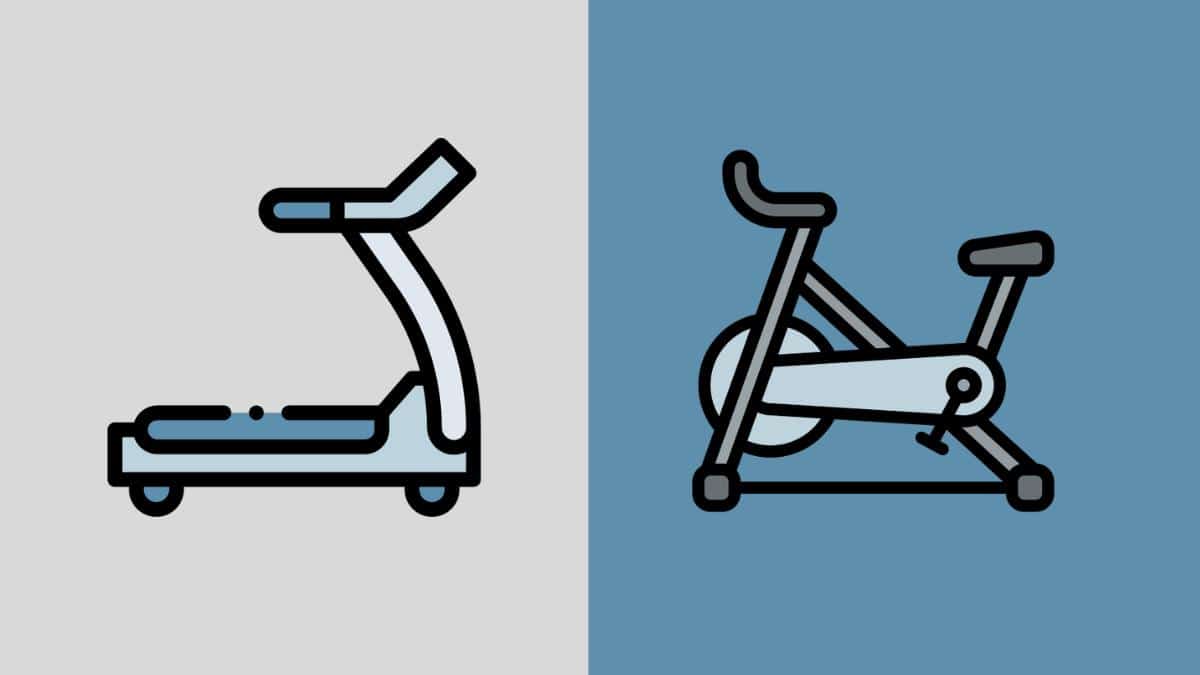
There is no shortage of types of cardio machines when you walk into the gym. Heck, you can do cardio without a machine, too (swimming, jumping rope, kettlebell swings, etc).
Two of the most popular cardio machines for weight loss are the treadmill and the stationary bike, and I’d argue they get a majority of the attention.
But which of the two is going to give you the best workout possible?
In this article, we will do a deep dive into the most important points of comparsion: calories burned, muscles worked, functional results, impact and injury, and, finally, the cost and space factor.
By the end of this post, you’ll have a clear idea which machine is the best investment of both your time and money.
So let’s dive right in and crank up the cardio.
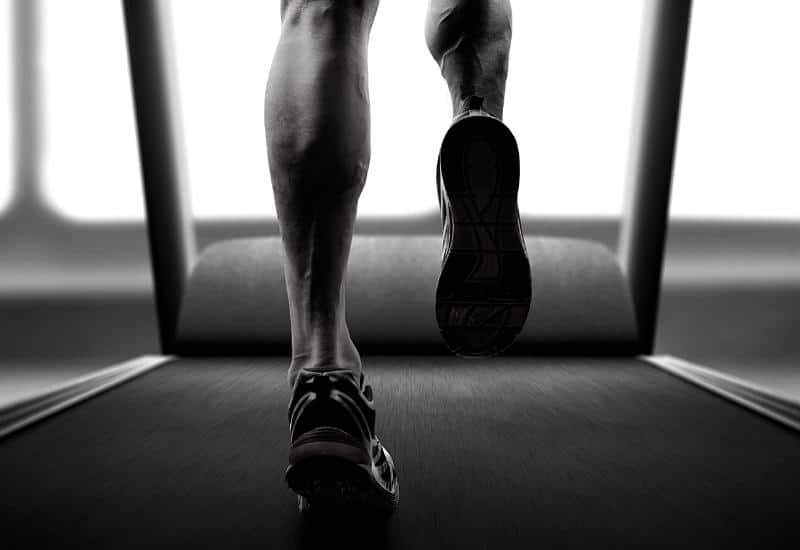
Treadmill vs Stationary Bike – Key Comparisons
Calories Burned
When it comes to figuring out which is the right cardio machine for torching fat, it’s always smart to start with the simplest and most easily quantifiable metric: the calories burned.
Weight loss can pretty much be boiled down to a simple formula: as long as you are expending more calories than you are consuming every day, you are at a calorie deficit, which forces your body to tap into stored fats to burn for energy.
There are a lot of other factors to take into account—everything from metabolic function to the composition of your diet to your unique genetics, and more—but at the end of the day, this simple formula is an easy one to follow.
Based on that formula, it stands to reason that any machine that burns more calories per minute or hour will be the better machine for weight loss. Simple and easy to understand, right?
So let’s see how the two stack up…
The treadmill is a good place to start, as always. According to Harvard Medical School1:
- In 30 minutes of fast-paced walking or slow-paced jogging, a 125-pound person can burn 180 calories
- In 30 minutes of fast-paced walking or slow-paced jogging, a 155-pound person can burn 216 calories
- In 30 minutes of fast-paced walking or slow-paced jogging, a 185-pound person can burn 252 calories
Not too bad a start, right? Granted, this is predicated on a slow pace; so what happens if you speed things up, and switch to a slightly faster jog?
- In 30 minutes of jogging at 6 MPH, a 125-pound person will burn 295 calories
- In 30 minutes of jogging at 6 MPH, a 155-pound person will burn 360 calories
- In 30 minutes of jogging at 6 MPH, a 185-pound person will burn 420 calories
All right! Now we’re getting into real results territory.
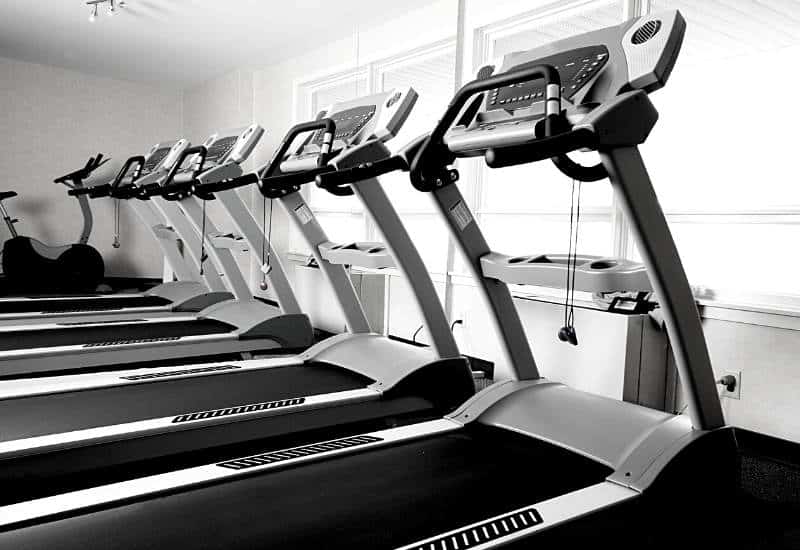
Let’s pick up the pace a bit more and run faster:
- In 30 minutes of jogging at 7.5 MPH, a 125-pound person will burn 375 calories
- In 30 minutes of jogging at 7.5 MPH, a 155-pound person will burn 450 calories
- In 30 minutes of jogging at 7.5 MPH, a 185-pound person will burn 525 calories
And what happens if we really push ourselves and try some sprint training?
- In 30 minutes of jogging at 10 MPH, a 125-pound person can burn 453 calories
- In 30 minutes of jogging at 10 MPH, a 155-pound person can burn 562 calories
- In 30 minutes of jogging at 10 MPH, a 185-pound person can burn 671 calories
Those are some numbers you can be proud of, and visible results that will make the time you invest well worth it.
Now, let’s see how many calories the stationary bike burns:
According to that same resource (Harvard Medical School):
- In 30 minutes of cycling at a “moderate” pace, a 125-pound person can burn 210 calories
- In 30 minutes of cycling at a “moderate” pace, a 155-pound person can burn 252 calories
- In 30 minutes of cycling at a “moderate” pace, a 185-pound person can burn 294 calories
That’s almost as much as a slightly faster jogging pace.
Not too bad, all things considered.
And if you increase the pace:
- In 30 minutes of cycling at a “vigorous” pace, a 125-pound person can burn 315 calories
- In 30 minutes of cycling at a “vigorous” pace, a 155-pound person can burn 378 calories
- In 30 minutes of cycling at a “vigorous” pace, a 185-pound person can burn 441 calories
Pretty much on par with a fast run, though not as many calories burned as you’d see doing sprint training.
At the end of the day, the treadmill has the potential for higher calorie-burning, but you may find that the “average” cycling workout on the stationary bike will burn fractionally more calories than you’d burn at a slow jog.
Muscles Worked
Cardio isn’t about training your muscles (that’s what resistance training is for), but the best cardio workouts will still give you at least a decent muscle-building workout.
I’m always in favor of any exercise that engages the full body—after all, more muscles worked means more calories burned, as well as greater overall fitness.

Some machines, such as the assault bike or elliptical machine, work your whole body. Others, like the rowing machine, works many of your muscles, though not all.
The treadmill and the stationary bike, however, are limited entirely to your lower body and core muscles.
When you run, your leg muscles do most of the work:
- Glutes
- Hamstrings
- Quads
- Calves
- Shins
With running at a flat level, the focus is chiefly on your quads. To shift it to your glutes and hamstrings, raise the treadmill to an incline.
There’s also some activation of your core muscles—your lower back and abs—to maintain stability and keep you balanced while you move.
On the stationary bike, you’re working pretty much the exact same muscles, though with slight variations.
For example:
- When you cycle from a seated position, pretty much the entire effort is performed by your quads.
- When you cycle standing up, your glutes and hamstrings join the party a bit more, lending support to your quads.
- If you hover back over your seat (like you do while spinning), you engage the glutes and hamstrings more.
The slight variations are enough to give you a fairly decent workout for your entire legs. Your abs and lower back help to keep your upper body upright while you cycle, too. If you lean heavily on the handlebars, the upper body is less used, though.
At the end of the day, neither machine has the real edge when it comes to muscles worked. However, as you’ll see in the next section, the way those muscles are worked can make all the difference in the world.
Functional Fitness
“Functional fitness” refers to your ability to perform your activities of daily life as efficiently as possible. The more a workout boosts that particular ability, the more “functional” it is.
The stationary bike is a fairly functional workout, all things considered. It’s safe to say that you’ll get on a bike at some point in your life, and being able to pedal well definitely comes in handy. Developing those pedaling muscles on the stationary bike is a great way to train for a “real life activity.”
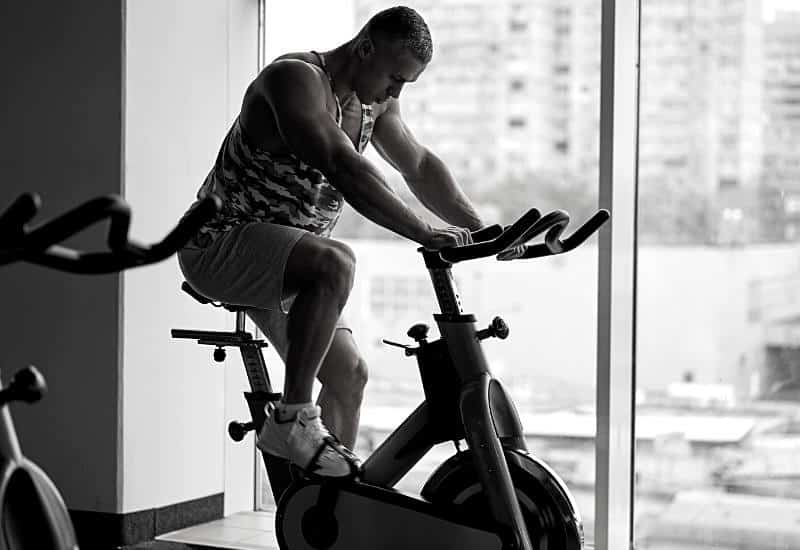
However, when it comes right down to it, no cardio machine is more functional than the treadmill. After all, you walk, jog, and run everywhere.
And if you’re trying to improve your cardiovascular conditioning, there are no better cardio machines for HIIT workouts than the good ol’ treadmill.
Sprint training improves your cardio capacity more efficiently than any other cardio workout, helping to improve the function of your lungs, heart, and blood vessels across the board.
Impact and Injuries
Both of these factors are critical to consider for anyone who trains regularly—they can make or break your training program!
Impact
When we talk about “impact” in regards to exercise, we’re talking specifically about the impact on your skeletomuscular system.
Lifting your feet off the ground and placing them down again does send some impact traveling up your bones, through your joints and muscles. The harder that weight gets placed down again, the higher the impact.
The impact that travels up your bones, joints, and muscle tissues can cause microscopic amounts of damage to these tissues. Over time, this damage can accumulate, until there is noticeable damage to the tissues—which, put into layman’s terms, translates into swelling, pain, and stiffness.
Repeated overuse and performance of high-impact exercise can damage the bones, joints, and muscle tissue, which can lead to injuries (see the next section).
- The highest-impact form of exercise around is jumping. All of your weight is leaving the ground, then coming back down again HARD.
- One rung down from jumping, you have sprinting and any very fast forward movement.
- Another step down, you have exercises like running and jogging.
- Then, on the lower-impact end of the spectrum, you have exercises like cycling or stair-climbing.
- And, at the very bottom, there are workouts like the elliptical machine or the rowing machine, which involve little to no impact at all.
As you can see, the treadmill is a higher-impact form of exercise than the stationary bike, which means a higher risk of overuse/wear and tear injuries.
Injuries
The more high-impact your exercise, the more prone you are to injuries.
The microscopic damage accumulates until it’s noticeable, and you experience pain, swelling, immobility, and even instability in your joints, bones, and muscle tissue.
With repeated high-impact training, the injuries get worse and worse. Which is why it’s strongly recommended that you mix up your high- and low-impact exercise to give your body a chance to rest and repair the microscopic damage.
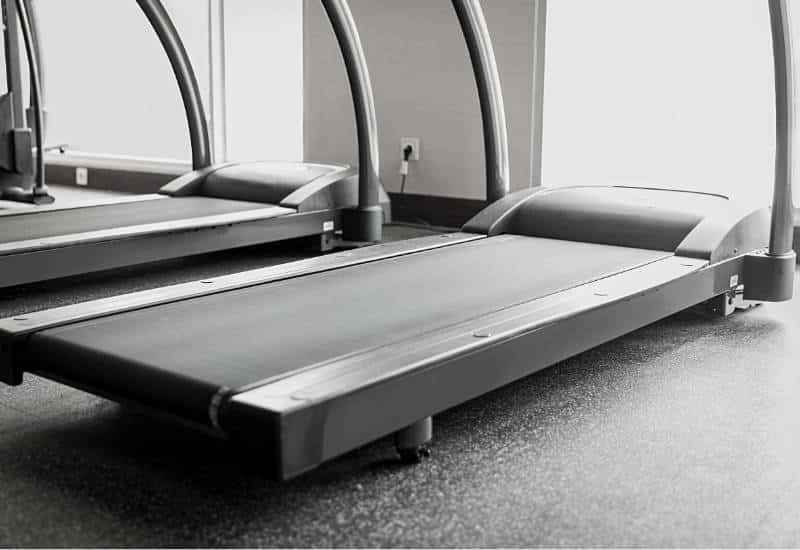
Given that the treadmill is a higher-impact machine than the stationary bike, there is this one element that contributes to a higher risk of injury.
However, it’s important to know that not all injuries are impact-related. Some are the result of overuse or incorrect use.
This is where the stationary bike has a significantly higher injury rate than the treadmill. On the stationary bike:
- You extend and bend your knees repeatedly, which can lead to a higher risk of knee injury
- You lean forward while pedaling, which can contribute to a higher risk of lumbar back pain and lower back injuries
There is a slightly higher injury risk on the stationary bike due simply to the posture you’re in while pedaling.
Cost and Footprint
These are two critical factors for anyone who is thinking of buying one of these cardio machines for their home gym use.
Cost
It’s going to be much harder to afford gym equipment that costs thousands of dollars, especially if you’re thinking of adding other free weights, cardio machines, and weight machines to your setup.
Thankfully, both treadmills and stationary bikes are fairly inexpensive machines.
On the budget end, you can find both treadmills and stationary bikes in the $150 to $300 range. They come with no bells and whistles, but they get the job done.
In the mid-priced range, you’re looking at $500 to $800, and $1,000 to $2,000 for the really high-end machines.
The cost is similar enough that they’re both suitable options for the average home gym.
Footprint
“Footprint” refers to the amount of space the machine takes up. The bigger the machine’s footprint, the more space is required, so the less likely it is that you’ll be able to fit it into a small basement, attic, living room, or garage home gym.
Your average treadmill will stand roughly 30 inches wide, and anywhere from 60 to 80 inches long (depending on the deck). However, many are designed to be folded up, which means they’ll occupy more vertical space (around 5 feet), but their footprint will be smaller (roughly 30 inches wide and 24 to 28 inches long).
The stationary bike, on the other hand, has a smaller footprint when fully set up—usually 50 to 60 inches long, and 24 to 30 inches wide. However, they aren’t typically designed to fold up, so they will always occupy that much space.
Treadmill vs Stationary Bike – The Final Verdict
The treadmill is the perfect choice for people who:
- Need a machine that can fold up small and take up less space in their gym when not in use
- Want to improve their fitness for walking, running, jogging, and sprinting
- Prefer to burn more calories at higher energy output
- Are interested in high-impact workouts
- Like to walk or run but can’t do so outdoors due to inclement weather
The stationary bike is perfect for people who:
- Want to train to be better cyclists
- Like to work out from a seated position rather than standing
- Like cycling more than walking or running
- Don’t need a machine that can fold up small when not in use
The Bottom Line
As you’ve seen above, both the stationary bike and the treadmill have a lot of “pros” and “cons”. They’ve got features that will work better for some people but be drawbacks to others.
Though their workouts are fairly similar in terms of muscles worked and overall results, and they both cost roughly the same, the end-goal of why you’re training will determine which is the better choice for you.
If you are (or plan to be) a cyclist, the stationary bike is the option that will help you train smart for your bike rides.
For anyone else, the treadmill is overall the better machine simply because it trains you to walk, run, and jog more efficiently.
More Articles and Guides Like This
Rowing Machine vs. Treadmill: Which One is Best for You? The rowing machine and the treadmill are both excellent cardio machines that deliver a lot of results. But which one will work best for you? Read on and choose the right machine for your goals.